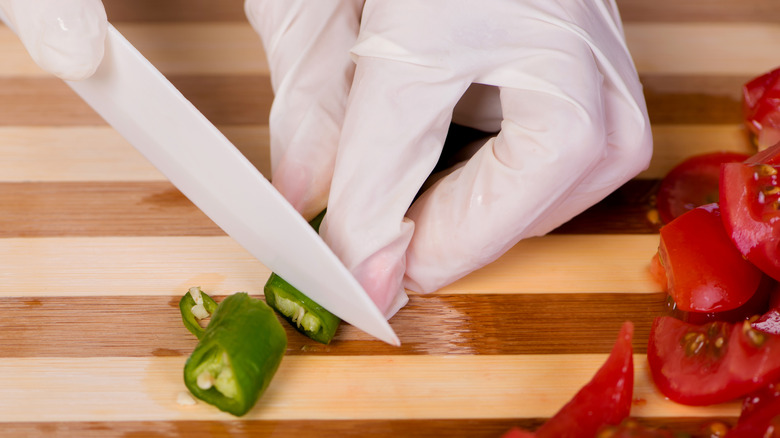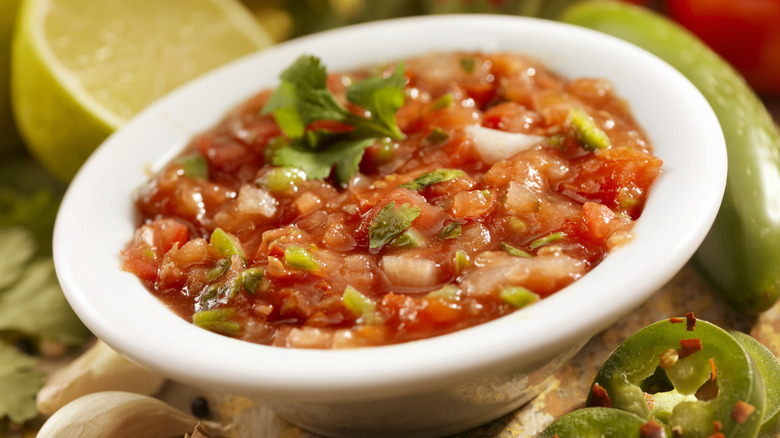Alton Brown Wears Surgical Gloves To Prep Salsa, And You Should Too
In his "Mix-and-Match Salsa" video, Alton Brown bids hasta la vista to store-bought, canned salsa in favor of his own homemade version. Before chopping hot chili peppers, he takes an important safety measure, and one you should too — he dons surgical gloves. Capsaicin from chilies (the chemical that makes them taste hot) sticks around, including on knives, cutting boards, and — perhaps worst of all — your hands. The lingering burn you might enjoy when eating salsa isn't so pleasant when transferred to your eyes or other body parts. Ouch!
Capsaicin oil in peppers causes the sensation of heat, both in your mouth and on your skin. Measured in Scoville Heat Units (SHU), chilies lower on the scale like jalapeño and chipotle (smoked jalapeño) range from 2,500 to 8,000 SHU — while spicier habanero and scotch bonnets rank 100,000 to 350,000. In comparison, weapons-grade pepper spray contains 2 million or more SHU, and one of the world's hottest peppers, the Apollo, tops the scale at 3 million.
Seeds grow inside chilies in a cluster at the top, surrounding glands that produce capsaicin oil. The oil flows into the fruit and is stored in the pith membranes (Brown calls these ribs). You may have heard the myth that by removing a chili's seeds, you'll tone down its heat, but pepper spice actually isn't in the seeds, which do not contain capsaicin. And no, not even soap and water is a surefire way to remove the oil from skin. Regardless of which part of a chili you are handling, put on gloves first to avoid a painful situation later.
Mild, medium, or spicy heat from one chili pepper
In Alton Brown's salsa video, he demonstrates multiple ways you can prep chili peppers to affect heat and flavor. For this recipe, he uses a jalapeño, which he cuts the top from, slices in half lengthwise, then scoops out the seeds. He explains that if you minced half of the jalapeño as is, with the ribs attached, your salsa would get the pepper's full heat. Laying the other half of the pepper flat, he carefully slices off the ribs. Once chopped, this piece of jalapeño will have a milder flavor, with less heat. He also shows how roasting chilis can add a third level of taste by releasing natural sugars, which helps temper the spice (per Physiol Behav).
Capsaicin is what makes food spicy, and since it is an oil, it can spread from the pepper to your hands — and then anything you touch. Because oils do not dissolve in water, washing with regular soap usually is not enough to remove capsaicin from your hands, which can remain invisibly stained with its burn for days. The only way to prevent this uncomfortable side effect of chili chopping is by wearing disposable gloves.
Latex or vinyl gloves are suitable, but if you really want to avoid jalapeño hands, the best gloves for this purpose are nitrile. Nitrile surgical gloves are food safe and designed to be chemical- and oil-resistant. They are an excellent choice to protect you from capsaicin.
Spicy salsa's mind-blowing secret
To make Alton Brown's salsa, use the chopped and roasted jalapenos described earlier. Dice tomatoes, garlic, red bell pepper, red onion, dry ancho chilies, fresh herbs — like cilantro, parsley, or scallions — and toss with olive oil, lime juice, chili powder, salt, and pepper.
If the salsa is too spicy, and your mouth feels like it's on fire, drink cold milk. The cold soothes while the acid, fat, and protein in milk act to neutralize fiery capsaicin. Milk is so effective at this that it's used in competitive chili eating where contestants bow out by drinking a glass of milk. Milk can help your hands too. First, wash with dishwashing or degreaser soap. Fill a bowl with milk, and soak your hands for a few minutes. Rinse and repeat if necessary. Vegans can try coconut milk or avocado, both high in fats that help douse the flame.
Here's where it gets weird. That burning on your tongue from too-hot salsa and tingling on your fingers after chopping chili — none of that's real. Capsaicin's heat is a chemical reaction that takes place in your brain, triggering pain receptors to think they're on fire, but there's no physical burn, your body just thinks there is. Mind blown! The pain may just be a chemical reaction, but pure, undiluted capsaicin can still blind you (via The Guardian). So follow Alton Brown's wise advice, and you won't suffer for salsa. Glove up before touching hot chilies to keep the heat in your salsa, not on your hands.



